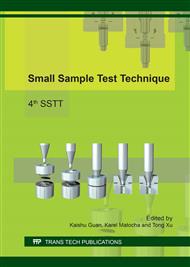[1]
CEN WORKSHOP AGREEMENT Small Punch Test method for Metallic Materials, CWA 15627: 2007 D/E/F, December (2007).
Google Scholar
[2]
HURST, R., MATOCHA, K.: Experiences with the European Code of Practice for Small Punch Testing for Creep, Tensile and Fracture Behaviour. Proceedings of the 3th International Conference SSTT 2014 Determination of Mechanical Properties of Materials by Small Punch and other Miniature Testing Techniques,. September 23 to 25, 2014, Castle Seggau near Graz, Austria, pp.1-26.
DOI: 10.1520/stp157620140005
Google Scholar
[3]
HURST, R.C. and MATOCHA, K.: The European Code of Practice for Small Punch Testing – where do we go from here? Metallurgical Journal Vol. LXIII, 2010. Conference proceedings of the 1st International Conference SSTT "Determination of Mechanical Properties of Materials by Small Punch and other Miniature Testing Techniques, August 31 to September 2, 2010, pp.5-11.
DOI: 10.4028/www.scientific.net/kem.734.3
Google Scholar
[4]
HURST, R., MATOCHA, K.: Where are we Now with the European Code of Practice for Small Punch Testing? Proceedings of the 2nd International Conference SSTT Determination of Mechanical properties of Materials by Small Punch and other Miniature Testing Techniques ,. October 2 to 4, 2012, Ostrava, Czech Rep., pp.4-18.
DOI: 10.4028/www.scientific.net/kem.734.3
Google Scholar
[5]
DYMÁČEK, P., JEČMÍNKA, M.: Applicability of Small Punch Testing Methods for Material Mechanical Properties at Room and High Temperatures. Proceedings of the 3th International Conference SSTT 2014 Determination of Mechanical Properties of Materials by Small Punch and other Miniature Testing Techniques, September 23 to 25, 2014, Castle Seggau near Graz, Austria, pp.65-74.
DOI: 10.4028/www.scientific.net/amm.821.435
Google Scholar
[6]
HA J.S., FLEURY E. Small punch tests to estimate the mechanical properties of steels for steam power plant: II. Fracture toughness. Int. J. Pres. Ves. & Piping 1998; 75: 707–13.
DOI: 10.1016/s0308-0161(98)00075-1
Google Scholar
[7]
FOULDS J.R. and VISWANATHAN R. Small punch testing for determining the materiál toughness of low alloy components in service J. Of Eng. Materials and technology V. 116 pp.457-464, (1994).
DOI: 10.1115/1.2904313
Google Scholar
[8]
MATOCHA K.: Small Punch Testing for Tensile and Fracture Behaviour – Experiences and way Forward. Application of Miniature Small Punch Test Specimen in Determination of Tensile Properties", Small Specimen Test Techniques, 6th International Symposium, ASTM STP1576, ASTM International, 100 Barr Harbor Drive, PO Box C700, West Conshohocken, PA 19428-2959, (2014).
DOI: 10.1520/stp157620140005
Google Scholar
[9]
JU J. -B., JANG J., KWON D.: Evaluation of fracture toughness by small-punch testing techniques using sharp notched specimens. International Journal of Pressure Vessels and Piping 80 (2003), pp.221-228.
DOI: 10.1016/s0308-0161(03)00042-5
Google Scholar
[10]
CUESTA I. I., RODRIGUEZ C., BELZUNCE F. J:, ALEGR J. M.: Analysis of different techniques for obtaining pro-cracked/notched small punch test specimens. Engineering Failure Analysis 18 (2011), pp.2282-2287.
DOI: 10.1016/j.engfailanal.2011.08.004
Google Scholar
[11]
LACALLE R., ÁLVAREZ J. A., CICERO S., GUTIÉRREZ-SOLANA F.: From Archaeology to Precious Metals: Four Applications of Small Punch test. Proc. 1st Int. Conf. SSTT (Small Sample Test Techniques), Vol. 63, p.59–68; 2010, Metallurgical Journal.
DOI: 10.1201/b10564-65
Google Scholar
[12]
TURBA K., GŮLCIMEN B., LI Y., BLAGOEVA D., HÄHNER P., HURST R.: Introduction of a new notched specimen geometry to determine fracture properties by small punch testing. Engineering Fracture Mechanics, Volume 78, Issue 16, November 2011, pp.2826-2833.
DOI: 10.1016/j.engfracmech.2011.08.014
Google Scholar
[13]
ADAMS, J., BACHE, M.R., HURST R.C. and BORRADAILE, J.B. Ductile-brittle transition characterisation of reactor pressure vessel steels using notched small punch specimens Proceedings of the 3th International Conference SSTT 2014 Determination of Mechanical Properties of Materials by Small Punch and other Miniature Testing Techniques,. September 23 to 25, 2014, Castle Seggau near Graz, Austria, pp.1-26.
DOI: 10.1115/pvp2015-45373
Google Scholar
[14]
ADAMS, J. Development of small specimen test techniques for toughness measurement Ph.D. thesis University of Swansea (2015).
Google Scholar
[15]
BLAGOEVA D, LI Y. Z, HURST R.C. Qualification of P91 welds through small punch creep testing. J Nucl Mater 2011; 409: 124–30.
DOI: 10.1016/j.jnucmat.2010.09.015
Google Scholar


